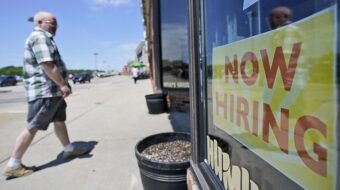News Analysis
PARIS — Two years have passed since the “insurrection of the suburbs” of working-class and immigrant youth in this city’s impoverished outskirts. The violent rebellion of 2005, which included young people setting fire to thousands of automobiles and engaging in street battles with the police, transfixed the nation for nearly three weeks.
At the time, Nicolas Sarkozy was minister of the interior under President Jacques Chirac. Sarkozy said he wanted “to clean with high-pressure water hoses the suburbs of the rabble [or ‘scum’] who pollute them.”
His provocative remarks were received by the inhabitants of these districts as the insults they were intended to be, but also as a symbol of hatred directed at the poor in general. His words were backed by thousands of police armed with truncheons and tear gas, deployed under a rare “state of emergency.”
When Sarkozy was elected president in 2007 after campaigning on a hard-line, anti-social-entitlements platform, one could only expect that the situation would worsen. Much of France understood this and consequently considered the latest explosion, which began on Nov. 25, as inevitable.
The new disturbances erupted after two youth of African descent, ages 15 and 16, were killed while riding a motorcycle in the city of Villiers-le-Bel. The accident involved a police car.
The suspicious circumstances surrounding the collision and the teens’ deaths, and the hurry of the police to deny all responsibility for the accident help explain why the inhabitants of the area rose up. Observers said that even ordinarily “quiet” people went out into the streets to demonstrate “against injustice.”
Facing reluctance by the authorities to open an investigation into the incident, and, simultaneously, seeing an increase in repression directed against the area’s youth, people became angry and the situation quickly degenerated. Young people, many with hoods over their heads, burned garbage bins, cars and stores.
More than a thousand members of the police force, supported by high-tech helicopters, were mobilized to suppress the rebellion in the Villiers-le-Bel and its neighborhoods — in Sarcelles, Garges-lès-Gonesse, Goussainville, Cergy-Pontoise, as well as in more distant municipalities of other departments of the Parisian region.
Police responded to the youth with tear gas, stun grenades, rubber bullets and paint guns, the latter to better identify them for subsequent arrest. But hundreds of young people continued to burn police cars and attack police stations with Molotov cocktails, sometimes using garbage-can lids as shields.
In their revolt against the established order, the young people focused their attacks on private property, often setting fire to it. They refrained from attacking people — except for the police force. In this connection there was a worrying change compared to the rebellion of November 2005: the level of aggressiveness toward the police was up sharply and included, in some cases, the use of firearms.
For three nights, several districts remained totally inaccessible to the police. As in 2005, the disorders took place only in or near the suburbs where the poorest families are trapped in towers and walls of concrete-slab housing.
While there is no figure for the number of young people who were injured, around 150 police officers were wounded in the clashes, some of them seriously. Some journalists were also injured in the fray.
Meanwhile, lawyers for the families of the deceased teenagers have announced they are filing a lawsuit to find out the truth about what happened to them.
The repression that is expected to come down on the arrested youths will no doubt be even more severe than it was in 2005, with summary sentences at the first court appearances and disproportionately harsh punishment, aggravated by the racism of the coupon-clipping French elite currently in power.
Without condoning the gratuitous violence, one has to observe that capitalist society — particularly under today’s harsh regime of neoliberalism — continues to offer nothing to its working-class youth: neither decent housing, nor education leading to stable employment, nor hope of social advancement, nor recognition.
The most tangible connection that many young people have with the capitalist state consists of being stopped, questioned and searched by the police, often in a brutal or humiliating way.
Even if the tactics of these young people in revolt do cause concern, the political left must see them as allies for the necessary social and democratic transformation of France — and not just a voting bloc in the next election.
Rémy Herrera is a researcher at the National Center for Scientific Research and teaches at the University of Paris Pantheon-Sorbonne.











Comments